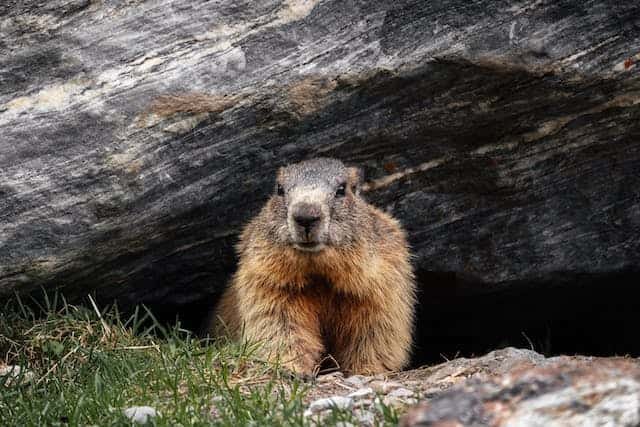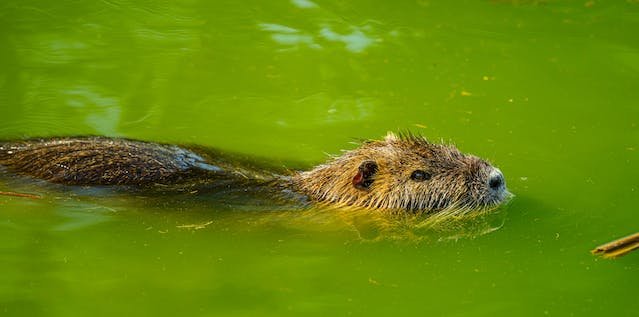Physical Address
304 North Cardinal St.
Dorchester Center, MA 02124
Physical Address
304 North Cardinal St.
Dorchester Center, MA 02124

Do groundhogs and beavers appear to be the same animal to you? Are they really the same animal, or is there a difference between a groundhog vs a beaver?
Groundhogs and beavers are rodents that belong to distinctive families. Groundhogs (also known as Woodchucks) are rodents that belong to the marmot family, while beavers are semi-aquatic mammals that belong to the family Castoridae.
Beavers are creative builders. They have the ability to build dams and lodges, especially during winter. Unlike beavers, groundhogs are naturally known for burrowing abilities.
These rodents are herbivores, and they feed on a variety of plants. Groundhogs prefer feeding on grasses, dandelions, and clovers, while beavers feed on the barks of trees.
Beavers and groundhogs make up 40% of rodents in the mammal population. Beavers are excellent swimmers, but groundhogs prefer to burrow on land.

Groundhogs are lowland animals naturally found in North America. They belong to a group of large ground squirrels called the marmots.
Groundhogs are naturally found on the continent of North America- specifically throughout the Eastern United States, to Canada and Alaska.
The groundhog is also called a wood-shock, ground pig, chuck, whistler, whistle pig, Canada marmot, red monk, land beaver, weenusk, thickwood badger, and moonack.
These rodents behave in a naturally unique way to survive and protect the colony. Groundhogs are great swimmers and will climb trees when threatened by predators.
They also climb trees when they need to survey their environment. Their natural instinct for survival includes standing almost motionless on their hind feet to signal for an incoming danger.
When groundhogs are alarmed, they use their high-pitched whistle to warn the colony of an imminent danger.
According to a popular American legend, it’s believed that groundhogs come out from their hibernation on February 2nd every year. This date is designated as the Groundhog Day.
Also Read: Buck vs Stag: Difference and Comparison
Beavers are large semi-aquatic rodents, the second largest living rodents in the world. These rodents can weigh up to 50 kg (110 pounds) and they are only found in the Northern Hemisphere.
Naturally, there are only two known existing species of beavers- which are the North American beaver and the Eurasian beaver.
These large rodents are semi-aquatic, so they are usually found in freshwater habitats such as lakes, streams, ponds, and rivers. Like groundhogs, beavers are herbivores and they feed tree barks, grasses, aquatic plants, and sedges.
Beavers are excellent swimmers with stout bodies, hand-like front feet, webbed back feet, long chisel tails, and large heads. Their ability to swim in rivers, ponds, streams, and lakes enables them to construct dams of branches, mud, and stones.
Beavers can measure up to 18 inches (45 cm) in length and up to 5 inches (13 cm) wide.

We will be looking at some of the differences between groundhogs and beavers. The common difference between a groundhog vs a beaver is the size of the rodents.
Compared to groundhogs, beavers are larger rodents- only the second to capybaras. Their behaviour and natural habitat are also different, as beavers are semi-aquatic rodents, while groundhogs are known for burrowing abilities.
Beavers require a water source to survive in the wild. Groundhogs are more terrestrial animals that survive and flourish underground.
Their preference for food sources is also another distinctive behaviour in these rodents. Beavers prefer to feed on tree bark, while groundhogs feed on crops, flowers, shrubs, and grasses.
Also Read: Doe vs Buck: Difference and Comparison
Beavers are semi-aquatic rodents that love to feed on tree bark. Their natural habitat includes rivers, streams, ponds, lakes, and marshes. Beavers need a water source to survive and the surrounding should provide a food supply, mainly aquatic plants and trees.
Their natural habitat also provides what is needed to construct dams.
Groundhogs are more terrestrial animals that survive and flourish underground. They naturally roam in fields, meadows, and open land areas with trees nearby.
Groundhogs prefer to burrow in drained soils or near gardens and buildings. These rodents usually cause crop loss and structural damage.
Beavers are large semi-aquatic rodents naturally found in the Northern Hemisphere. Capybaras are the only rodents in the world that are larger than beavers.
Beavers can weigh up to 50 kg (110 pounds) and grow up to 18 inches (45 cm) in length.
On the other hand, groundhogs are smaller rodents that can weigh between 10 to 20 pounds and measure up to 2 feet in length.
Groundhogs are great swimmers and will climb trees when threatened by predators. These rodents belong to the marmot family and they are the second-largest rodents, only second to the hoary marmot.
Also Read: Squid vs Octopus: Difference and Comparison
Groundhogs and beavers prefer to feed on a similar diet, but there are some differences regarding their food source.
Both beavers and groundhogs are herbivores, so they both feed on plants. However, the beaver’s diet depends on the different seasons of the year.
Beavers mostly feed on plants such as rushes, cattails, water lilies, and sedges during summer and spring. In fall and winter, they prefer to feed on the diets of trees.
Beavers are known to feed on trees, but they only crunch on the cambium section of the tree- the inner bark of the tree that contains nutrients.
Trees that beavers prefer to feed on include oaks, aspen, birch, dogwood, alder, and willow.
Groundhogs are also herbivores that feed on plants. They also search their surroundings for food sources from small insects, to coltsfoot, clover, and dandelion.
Grasses and flowers are also on the list of food consumed by groundhogs. Other food sources that groundhogs can survive on include buttercup, berries, wild lettuce, buckwheat, and alfalfa.
Grasshoppers, snails, chicks, and grubs are all food source for groundhogs.
Also Read: Slug vs Snail: Difference and Comparison
Groundhogs are herbivores that prefer to burrow in drained soils or near gardens and buildings.
They also climb trees when they need to survey their environment. Their natural instinct for survival includes standing almost motionless on their hind feet to signal for danger.
When groundhogs are alarmed, they use their high-pitched whistle to warn the colony of an imminent danger.
In summer, groundhogs spend most of their time foraging for food. They also socialize with others during the summer months. During fall, these rodents begin to prepare for hibernation, with enough food already stored to survive the coming winter months.
Like groundhogs, beavers are also observant to prepare for winter. They construct dams and lodges, cutting down trees with their razor-sharp teeth.
| Groundhog | Beaver | |
| Natural habitat | Forest, suburban gardens, or woodlands. | Semi-aquatic mammals areb naturally found in rivers, lakes, streams, ponds, and marshes. |
| Size | Weighs between 10 to 12 pounds and can measure up to 2 feet in length. | Can weigh up to 50 kg (110 pounds) and measure up to 18 inches (45 cm) in length and up to 5 inches (13 cm) wide. |
| Evolution | Rodents that naturally belong to the Marmota Genus. | Large rodents belonging to the suborder Castormorpha, ancestors migrated to North America about 12 million years ago. |
| Diet | Mostly grasses, plants, shrubs, flowers, and vegetables. | Mostly leaves, grasses inner barks and roots. |
Groundhogs and beavers are rodents with a similar appearance, but they differ in their natural behaviour, habitat, preferred food source, and size.
Both beavers and groundhogs are herbivores, so they both feed on plants. However, the beaver’s diet depends on the different seasons of the year.
Beavers mostly feed on plants such as rushes, cattails, water lilies, and sedges during summer and spring. In fall and winter, they prefer to feed on the diets of trees.
Groundhogs and beavers prefer to feed on a similar diet, but there are some differences regarding their food source.